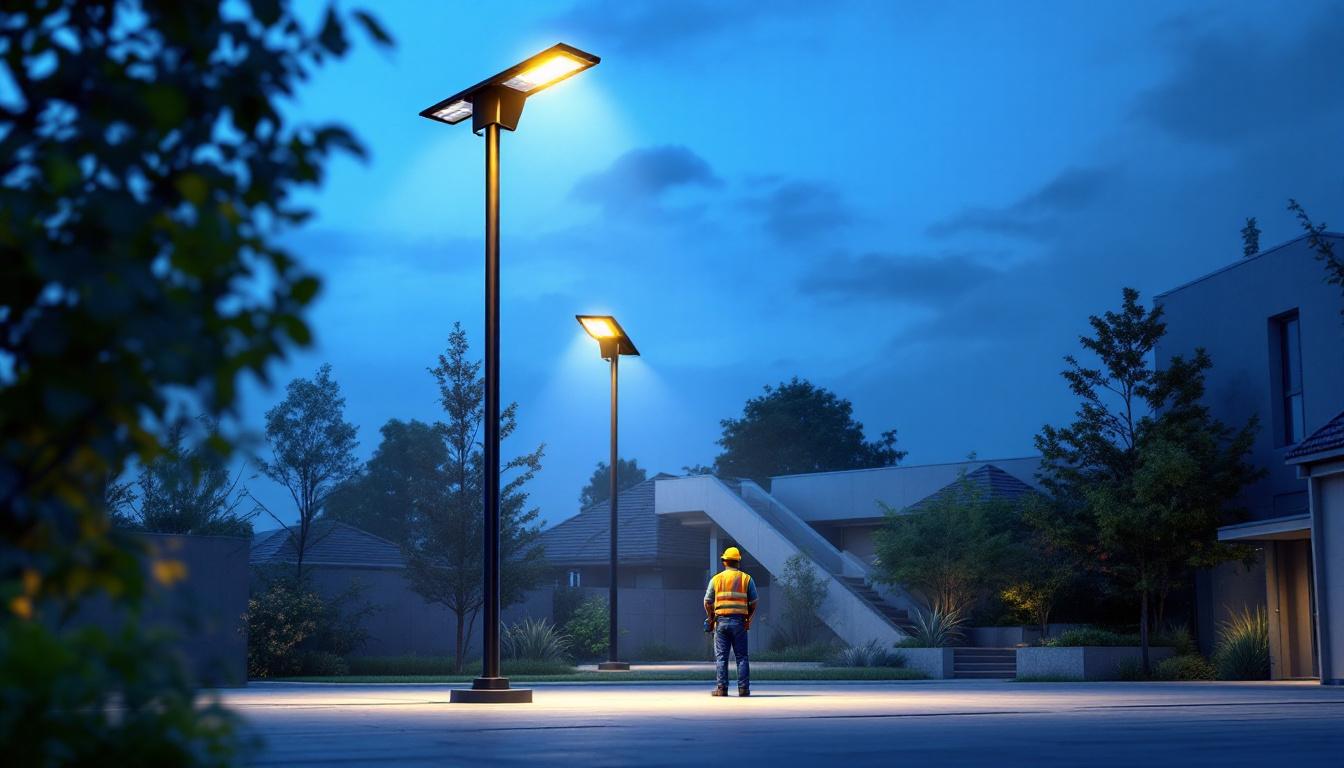
In the ever-evolving landscape of commercial lighting, understanding the nuances of the industry is crucial for lighting contractors. With advancements in technology, shifts in customer preferences, and regulatory changes, staying informed is not just beneficial; it is essential. This article aims to demystify the commercial lighting industry by exploring key aspects that every lighting contractor should know.
The commercial lighting market encompasses a wide range of applications, from office buildings and retail spaces to warehouses and outdoor environments. Each segment has its unique requirements and challenges, making it vital for contractors to tailor their approach accordingly.
Commercial lighting can be segmented into various categories, including general lighting, task lighting, and accent lighting. General lighting provides overall illumination, while task lighting focuses on specific areas where activities are performed. Accent lighting, on the other hand, is used to highlight particular features within a space. Understanding these categories allows contractors to recommend appropriate solutions that meet client needs.
Additionally, the market is influenced by the type of establishment being served. For instance, retail spaces may prioritize aesthetics and energy efficiency, while warehouses might focus more on functionality and durability. Recognizing these distinctions is key to successful project execution. Furthermore, the rise of mixed-use developments has led to a blending of these categories, where spaces serve multiple purposes, requiring a more nuanced approach to lighting design. Contractors must be adept at creating versatile lighting solutions that can adapt to various functions throughout the day.
The commercial lighting industry is witnessing several emerging trends that contractors should be aware of. One significant trend is the shift towards energy-efficient solutions, driven by both regulatory requirements and consumer demand. LED technology has become the standard, offering longer lifespans and lower energy consumption compared to traditional lighting options.
Another trend is the integration of smart lighting systems, which allow for enhanced control and automation. These systems can be programmed to adjust based on occupancy, time of day, or specific tasks, leading to increased energy savings and improved user experience. Moreover, the advent of Internet of Things (IoT) technology is paving the way for advanced lighting solutions that can communicate with other systems within a building, such as HVAC and security systems. This interconnectedness not only enhances operational efficiency but also provides valuable data analytics that can inform future design and maintenance decisions. Contractors who stay abreast of these trends will be better positioned to offer innovative solutions to their clients.
Regulations play a significant role in shaping the commercial lighting landscape. Lighting contractors must navigate a complex web of codes and standards that govern everything from energy efficiency to safety. Familiarity with these regulations is crucial to ensure compliance and avoid potential penalties.
Energy efficiency standards, such as those set by the Department of Energy or local building codes, dictate the minimum performance criteria for lighting products. Contractors should be well-versed in these standards to advise clients on compliant products and systems. Failure to comply can result in costly retrofits or fines, making it imperative to stay informed about the latest requirements.
Moreover, many jurisdictions offer incentives for energy-efficient installations, which can be an attractive selling point for clients. Understanding these incentives can help contractors position their services more effectively and enhance client satisfaction. For instance, tax credits, rebates, or grants can significantly reduce the upfront costs for clients, making energy-efficient solutions more accessible and appealing. By leveraging these financial benefits, contractors can not only boost their sales but also contribute to a more sustainable future.
Safety regulations are another critical aspect of the commercial lighting industry. Contractors must ensure that all installations adhere to safety codes, such as the National Electrical Code (NEC). This includes proper wiring practices, fixture placement, and the use of appropriate materials.
Additionally, contractors should be aware of specific safety considerations related to different environments. For example, lighting in industrial settings may require additional protective measures to withstand harsh conditions. By prioritizing safety, contractors can protect their clients and their own reputations. Furthermore, regular training and certification programs can help contractors stay updated on the latest safety practices and technologies. This not only enhances their skill set but also instills confidence in clients, knowing that their installations are being handled by knowledgeable professionals who prioritize safety and compliance.
Furthermore, the integration of smart lighting technologies is becoming increasingly prevalent in commercial spaces, which introduces a new layer of regulatory considerations. As these systems often involve connectivity and data transmission, contractors must also be aware of regulations concerning cybersecurity and data privacy. Ensuring that smart lighting solutions comply with these regulations is essential to protect both the client’s and the end-users’ information. This evolving landscape requires contractors to be proactive in their approach, continually educating themselves on emerging technologies and their associated regulatory frameworks to provide comprehensive solutions to their clients.
Effective lighting design is a cornerstone of successful commercial projects. Contractors should be equipped with the knowledge and skills to create lighting plans that enhance functionality, aesthetics, and energy efficiency.
The layout of lighting fixtures is critical in achieving the desired illumination levels and ambiance. Contractors must consider factors such as ceiling height, room dimensions, and the purpose of the space when designing lighting layouts. A well-thought-out layout can significantly improve the overall user experience.
Moreover, contractors should be adept at using lighting design software to create visual representations of their plans. This not only helps in client presentations but also aids in identifying potential issues before installation begins.
Another important aspect of lighting design is understanding color temperature and color rendering. Different color temperatures can evoke various moods and affect productivity. For instance, cooler temperatures are often preferred in office environments to promote alertness, while warmer temperatures may be more suitable for restaurants to create a cozy atmosphere.
Color rendering, measured by the Color Rendering Index (CRI), is also vital. High CRI lighting allows colors to appear more vibrant and true to life, which is particularly important in retail settings. Contractors should educate clients on these aspects to help them make informed decisions.
Technology is rapidly transforming the commercial lighting industry, and contractors must stay updated on the latest innovations to remain competitive. From advanced lighting controls to energy management systems, technology is reshaping how lighting is designed, installed, and managed.
Smart lighting systems are at the forefront of this technological revolution. These systems utilize sensors and automation to optimize lighting based on real-time conditions. For example, occupancy sensors can turn lights on or off based on whether a space is in use, significantly reducing energy consumption.
Contractors should be knowledgeable about various smart lighting products and their integration capabilities. This includes understanding how to connect lighting systems to building management systems (BMS) for centralized control. By offering smart solutions, contractors can enhance their value proposition and meet the growing demand for energy-efficient systems.
In addition to smart systems, advanced lighting controls are becoming increasingly popular. These controls allow for customizable lighting scenes, dimming capabilities, and scheduling options. Contractors should be familiar with the different types of lighting controls available, including wired and wireless options, to provide tailored solutions for clients.
Moreover, educating clients on the benefits of lighting controls can lead to increased satisfaction and energy savings. Demonstrating how these systems can enhance the user experience will position contractors as trusted advisors in the industry.
Effective project management is essential for successful lighting installations. Contractors must possess strong organizational skills and the ability to collaborate with various stakeholders, including architects, interior designers, and electrical engineers.
Collaboration is key in the commercial lighting industry. Lighting contractors should establish strong relationships with other professionals involved in the project to ensure seamless integration of lighting systems. This includes understanding architectural plans and coordinating with electrical engineers to avoid conflicts during installation.
Regular communication and meetings can help address potential issues early in the process, leading to smoother project execution. By fostering a collaborative environment, contractors can enhance their reputation and build lasting partnerships.
Time and budget management are critical components of successful project delivery. Contractors should develop detailed project timelines and budgets to keep projects on track. This includes accounting for potential delays and unforeseen expenses.
Utilizing project management tools can streamline this process, allowing contractors to monitor progress and make adjustments as needed. By effectively managing time and budget, contractors can ensure client satisfaction and maintain profitability.
In a competitive market, providing exceptional customer service can set contractors apart. Educating clients about their lighting options and the benefits of various technologies can lead to more informed decisions and increased trust.
Contractors should offer comprehensive consultations to assess client needs and preferences. This includes discussing energy efficiency, aesthetics, and functionality. By taking the time to understand client goals, contractors can tailor their recommendations and build strong relationships.
Additionally, providing samples or mock-ups can help clients visualize the proposed solutions. This level of engagement not only enhances client satisfaction but also positions contractors as experts in their field.
After-sales support is another critical aspect of customer service. Contractors should be available to address any questions or concerns that may arise post-installation. Offering maintenance services or warranties can further enhance client confidence and loyalty.
By prioritizing customer education and support, contractors can foster long-term relationships and encourage repeat business. Satisfied clients are more likely to refer others, contributing to the contractor’s growth and success.
The commercial lighting industry is complex and dynamic, presenting both challenges and opportunities for lighting contractors. By understanding market trends, regulatory requirements, design principles, and technological advancements, contractors can position themselves as knowledgeable professionals in the field.
Moreover, effective project management, collaboration, and customer education are essential for delivering successful lighting solutions. By prioritizing these aspects, contractors can enhance their reputation, build lasting client relationships, and ultimately thrive in the competitive commercial lighting market.
As the industry continues to evolve, staying informed and adaptable will be key to success. Embracing innovation and prioritizing client satisfaction will ensure that lighting contractors remain at the forefront of the commercial lighting industry.
Ready to elevate your lighting projects with the best in the industry? At LumenWholesale, we provide lighting contractors like you with top-quality, spec-grade lighting products at unbeatable wholesale prices. Say goodbye to local distributor markups and hello to our extensive selection that meets the highest industry standards. With free shipping on bulk orders, you can trust that you’re getting premium lighting at the best value — all without hidden fees or compromises. Don’t miss out on the perfect blend of quality, affordability, and convenience. Wholesale Lighting at the Best Value is just a click away. Make the smart choice for your lighting needs with LumenWholesale.

Discover how large solar lamp posts are revolutionizing the lighting industry by enhancing efficiency and sustainability for contractors.

Explore the world of light switches with insights from a seasoned lighting contractor.

Discover the rising trend of square pot lights and their transformative impact on modern lighting design.

Discover why America Lighting is a crucial partner for lighting contractors, offering innovative solutions and unparalleled expertise to illuminate projects of all sizes.